24 November, 1998
Tuesday, November 24th, 1998
Hi! What a FANTASTIC day! Hats off to Fred Atwood (another TEA teacher) for
arranging a little "field trip" to visit with scientists studying seals at Big
Razorback Island. What an awesome experience!
Fred and I left McMurdo around 10:15 AM, on Skidoos, bound for Big Razorback
Island and the remote camp there. Don Siniff, from the University of
Minnesota, started studying Weddell seals in this area of Antarctica in 1969.
He was asked to begin this study, which turned out to be a long-term
commitment…now almost 30 years in the making! At the time, Don was working on
large animal (caribou and otter) populations. I'm sure that traveling to and
working in Antarctica was an exciting opportunity for him!
We arrived at the remote camp in about 30 minutes…a gorgeous day to be
traveling around in Antarctica! Blue skies and sunny….perfect weather for a
field trip and a ride on a snowmobile. Almost immediately, I felt comfortable
with the scientists we met at Big Razorback. They were so friendly and
welcomed us to share their day! We helped them out by taking a group
photo…they hadn't had many visitors, so they didn't even have a photo of their
entire science team yet. Sadly, I don't remember everyone's names…we spent
most of our day with Mike Cameron…our tour guide for the day!
What a tour guide he was…answering all of our questions, giving us so much
information that I could barely keep up taking notes. This time I had brought
along paper and a pen. I had learned from previous experience (like out at
the Cape Roberts drill site) that I can't remember all of the facts and
figures presented to me when I'm interviewing people, so I need to take notes.
I quickly filled up my sheet with all of the facts Mike was telling us. I
will share lots of these facts in just a bit.
We spent the rest of the morning with Mike, hiking around Big Razorback
Island. He was telling us that they think that the islands around this area
once formed a huge caldera from a volcano. The jagged tops of the islands
reminded me of Crater Lake in Oregon, which is a volcanic caldera, too. All
the while we were hiking, views of Mt. Erebus dominated the scene! It's such
a presence when the sky is bright and sunny. Small puffs of steam rose from
the summit of the mountain. How many photos of one mountain do I need to
have? Who knows, but I'm sure that I'll have plenty of Mt. Erebus when I
return home.
As we hiked at a leisurely pace with Mike, he explained the life history of
Weddell Seals to Fred and I. We were able to see mothers and pups up
close…which is a real treat. The Antarctic Treaty protects the animals here.
Ordinarily people have to remain at least 5 meters from animals, and cannot
approach them, or you will be in violation of the Antarctic Treaty. If their
behavior changes, you must back off and leave them alone. If they approach
you, which does happen, then you are to remain still and not bother them.
Today was a little different. Since we were joining scientists working on a
project, we had the opportunity to get a closer look. These scientists have
permits that allow them to approach animals for tagging and other studies such
as blood work. As a matter of fact, other members of Mike's team were taking
blood samples as we worked our way around Big Razorback.
Several times throughout our hike, I saw pups and/or females slide into ice
holes to reach the water, or saw them in the ice holes ready to come back onto
the sea ice. The noises that the seals made were incredible to listen to.
There were snorts, whines, helicopter sounds, barks, and an amazing assortment
of communications. They came in different speeds, pitches, lengths, and
emphasis. Some seemed like warnings, others like nervous habits…I'm sure
brought on by our presence close by. It was all quite fascinating.
Mike is a graduate student who is studying the movement of seals within a
certain study area. This is the southern most breeding mammal in the world,
and a lot can be learned by doing a long-term study such as the one Don's been
working on since 1969. Mike will be looking at survivorship and reproductive
rates and parameters of these, as well as immigration and emigration (moving
in and out) of this study area and how that affects population numbers inside
the study area. For this parcticular project, the study area stretches from
Scott Base (near McMurdo) all the way to Cape Evan (where Robert Scott's hut
is located). It's a huge area, and this involves a lot of time and effort on
the part of the science teams, to monitor the seals and make sure they are all
tagged.
Data is recorded on small hand held computers, and later transferred to laptop
computers back at the remote camp. At the present time there are 30 years of
records, with 120,000 individual animal sitings, and over 13,500 animals
tagged. Scientists have learned so much because of the long-term data base of
information they have collected.
Weddell Seal pups are about 60 pounds at birth. By the time they are weaned
from their mother (about 6 weeks later) they can weigh 180 pounds. The milk
they drink from their mother is heavily laden with fat. There is a great
energy transfer from the mother to pup. For every 2 pounds that a mother seal
loses while nursing a pup, the pup itself gains 1 pound. Pups do not have the
blubber that adults do, so they are kept warm by their soft thick fur, called
"lanugo" fur. Adult seals have blubber to protect them from the cold. The
lanugo fur was wispy, soft, and light gray in color. Within a short period of
time the pup loses this fur and gains the weight (and fat) it needs to survive
the icy cold water surrounding Antarctica. We saw many pups that were quite
large and already losing the lanugo fur.
This study area had traditionally had around 390 pups born in it each year.
Last year was a boom year with 550 pups total. In one 2-day period of time,
over 200 pups were tagged. This year 489 pups were recorded and tagged. One
theory Mike gave us for the increase in population was that 7 years ago, it
was a pretty good year to be a pup. The survivors of that time period have
done well. It usually takes seals around 7 years before they have pups. Peak
"pupping" time here in the Erebus Bay area is usually Halloween.
Pups do not have the greatest chances of survival. Scientists have learned
that 15% of pups die between birth and weaning. 50% of the pups die between
weaning and the time they are one year old. After one year survivorship
increases. By the time they are adults (between 5-7 years old), they have a
98% chance of survival. Being a pup is dangerous business. As the pups grow
to be about 3-4 weeks old, mom starts to take the pup to water. The pup
usually bawls (cries out) in distress. Finally it gives in and joins mom in
the water. Mom takes the pup over and over to swim and forage for food.
Often it is hard for pups to get back out of the ice hole and water onto the
sea ice. Mom has to help out by using her teeth to rough up the surface of
the ice hole, making it easier to get out, or by giving the pup a boost up out
of the water. Even so, some pups do drown.
Mom leaves the pup after weaning and the pup usually bawls for a week. By
this point, the pup has gained sufficient weight and fat and is a butterball.
It has the tough job of finding its own food in the ocean. The pups spend
about 4 years away from the study area, learning to survive on their own and
growing up a bit. Eventually they come back to the study area where they were
born.
I also saw male seals with radio transmitters attached to their backs. These
transmitters are attached to the seal's body using a sort of super glue. The
transmitters eventually fall off as the seal molts later in the season.
Because of the transmitters, scientists can hear a signal if the seal is up on
the ice, they can study behavioral data, and there is also a depth pinger that
gives information about how far they dive down under water. We saw the radio
towers that are temporarily put up on the sea ice, during the data collecting
part of the summer season. The battery and computer are stored in a Coleman
cooler…they use bungy cords to keep the cooler closed tightly. Solar panels
are used to charge the battery, making use of a very abundant source of energy
here in Antarctica…the sun! An antenna is located at the top of a pole, and
the pole is secured by tether ropes coming out in several directions and
anchored in the ground. Quite an operation.
Arriving back at camp at around 1:30 PM, we were treated to a home-cooked
Mexican lunch by Mike…man of many talents! It was so much better than our
usual lunches in town! And all cooked on a Coleman two burner stove! The
biggest treat for me was Chips Ahoy cookies. I haven't had a good cookie
since leaving Christchurch, New Zealand! I could have eaten the whole
package! The field camps get priority for all kinds of goodies, and Mike was
telling us that "Pringles" potato chips are one example of things reserved for
"deep field camps" or more remote sites. Back in McMurdo last night, we had
the first "freshies" in weeks. Freshies are fresh fruits and vegetables. A
plane had arrived, bringing with it lots of GREAT fresh stuff. Freshies are
usually more readily available in the field camps. I guess it's their reward
for being stuck out in remote areas.
After lunch Mike, Fred, and I were joined by Dan, another one of the
scientists on the team. We rode on snowmobiles to two nearby islands…Tent
Island and Inaccessible Island. The purpose of this afternoon was to check
every seal we saw to see if it had the proper tags still on its flippers.
Sometimes the tags break off, and have to be replaced. Each seal has two
tags…one on each flipper. The tags have varying colors and numbers. The
color and number is recorded in the data base and used to log information
about the seal population in the study area.
I wish I had kept track of how many seals we checked out this afternoon. Tent
Island proved to be the better area for the seals…maybe because it had so many
cracks in the ice for the seals to come up through. We found quite a few with
broken or missing tags, and I got to watch them re-tag these animals. Dan
would carefully approach these seals with a cone-shaped rubber bag, with rope
handles. As he slowly came toward the seal, waiting for just the right moment,
Mike would distract the animal. Dan moved quickly and carefully to place this
bag over the seal's head and then he had to sit on top of the seal to keep the
bag on. Sometimes it reminded me of a rodeo event. His aim was terrific and
he had to bag quite a few of them.
While Dan was doing his part, Mike worked quickly to remove any old tags (or
remnants of tags) and put new ones on each flipper. He recorded this
information in a log book. The device he used to put the tags on reminded me
of something you'd use to pierce someone's ears…only much larger. The sharp
end of the tag was cut off after piercing the flippers…to prevent the seal
from hurting itself with it. The whole tagging process didn't take that long
for each individual animal, but we rode around the islands for several hours
doing this.
Before I knew it, it was 5:15 PM and the afternoon had slipped away. I was
very reluctant to leave this beautiful location and the fun of this project.
I thoroughly enjoyed this adventure and I want to thank Mike and Dan for a
great afternoon. Thanks especially to Mike who put up with the questions of
two teachers….and did a FANTASTIC job!
Fred and I sped off on our Skidoos-headed back to McMurdo. It took us about
45 minutes to get back to town. By the time we secured and covered the
snowmobiles, and walked up to dinner, it was nearing 7:00 PM. I ran into my
paleomag team and found out that Gary had spent the afternoon at the Cape
Roberts drill site, so we needed to drill samples this evening. Fabio and I
worked for about an hour, with Sonia helping Gary inside the core sampling
room. The work went much quicker with four people helping out.
Later, we all went to a party at the scuba diver's building. It was to
celebrate Hunter's (one of the divers) birthday, along with Fabio's. A good
chance to unwind with friends and listen to some music. A great end to a
WONDERFUL day! Talk with you tomorrow.
Betty :)
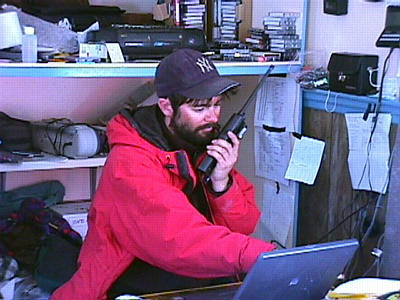
Mike Cameron--our guide for the day. He's working with a scientist out in the field who needs information that's stored in the data base on the computer. They rel ay the information back and forth with radios.
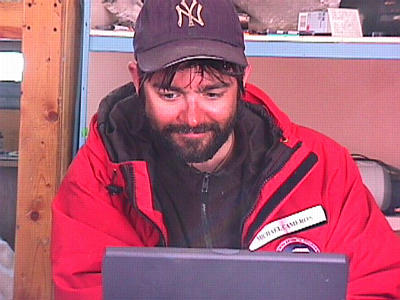
Mike and the other scientists spend hours logging their data in the field and then transferring that to the computer. The information they gather is very valuable in determining the life history of the Weddell Seal population in the study area between Cape Evans and Scott Base.
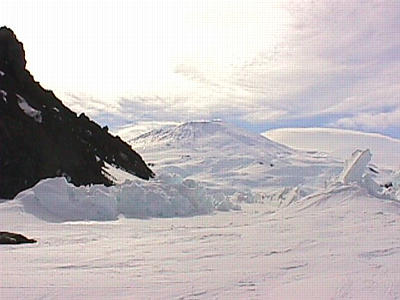
Mt. Erebus with Big Razorback Island in the left part of the picture. What a beautiful backdrop for a field camp.
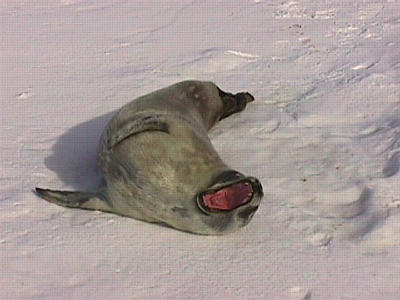
This seal pup was not all that happy that we were close by. It was whining at us very loudly! We heard lots of strange sounds today!
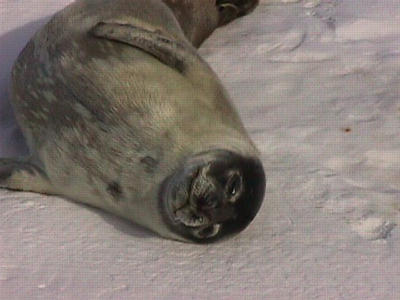
Here's a pup that was a little more relaxed about our visit.

Like I said in my journal, I felt like I was watching a rodeo event. Dan carefully put the bag over the seal's head, then sat on top while Mike did the tagging.
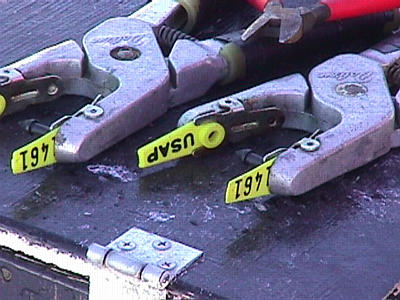
This photo shows the tags and the tool used to punch them through the seal's flippers. Notice the numbers on each tag.
Contact the TEA in the field at
.
If you cannot connect through your browser, copy the
TEA's e-mail address in the "To:" line of
your favorite e-mail package.
|
